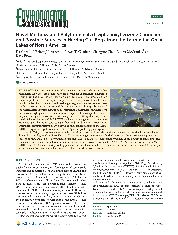摘要
An increasing number of brominated flame retardants and other brominated substances are being reported in herring gull eggs from the Laurentian Great Lakes basin. Yet, in extracts from gulls' eggs, numerous bromide anion response peaks in electron capture negative ion (ECNI) mass chromatograms remain unidentified. Using archived herring gull egg homogenates, we characterize the structures of three major and three minor, new and unique brominated substances. After extensive cleanup and separation to isolate these substances from the extracts, high-quality ECNI and electron impact (El) mass spectra revealed fragmentation patterns consistent with congeners of methoxylated polybrominated diphenoxybenzene (MeO-PBDPB), where four congeners contained five bromines and the other two contain four and six bromines, respectively. Optimized, semiquantitative analysis revealed sum concentrations of the MeO-PBDBP congeners ranged from <0.2 to 36.8 ng/g ww in pooled egg homogenates (collected in 2009) from fourteen herring gull colony sites across the Great Lakes, with the highest concentration being for Channel-Shelter Island in Saginaw Bay (Lake Huron). To our knowledge, there are no published reports on the environmental presence and sources of MeO-PBDPBs. We hypothesize that these MeO-PBDPBs are degradation products of the polybrominated diphenoxybenzenes, for example, tetradecabromodiphenoxybenzene (currently marketed as SAYTEX 120) or polybromo 3P2E. MeO-PBDPBs in Great Lakes herring gull eggs indicates their bioaccumulation potential, and raises concerns about their origin, environmental behavior and influences on wildlife and environmental health.
- 出版日期2011-11-15
